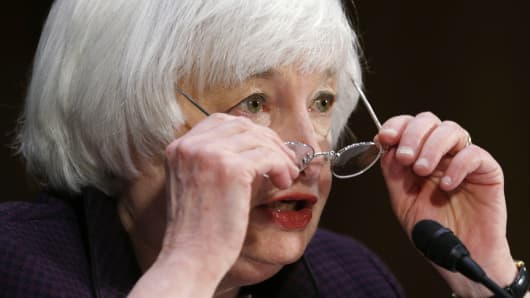The Federal Reserve will not be able to raise interest rates this year. Why? Sustainable economic growth has not and is not occurring. While most economists are predicting a sustainably growing U.S. economy that will lead the rest of the world out of stagnation, outside of more rapid employment growth. there is no evidence that is happening.
And here's why the job growth is not as bullish as most believe: Over the past 13 months, there have been 3.4 million jobs created versus 2.6 million over the comparable prior 13 months. The main reason for the extra 800,000 jobs was the end of 2013 cessation of super extended unemployment benefits. Those folk dropped off the dole had to take minimum wage 30 hour-type jobs. That is why wage growth is non-existent. The newly employed making minimum wage are not taking home very much more than what they made via unemployment benefits plus food stamps.
Indeed, almost all economists — and Fed governors are also economists — have been incorrectly predicting over the past several years that interest rates will have to rise because of an improving economy. And like Godot, the improving economy has never arrived. That is why I continue to predict ever higher bond prices and lower yields — and why the consensus of economists will continue to be wrong in predicting a bond bear market.
Read MoreBond strategist: 'Get out of bonds'
In fact, as opposed to takeoff velocity, the U.S. economy is slowing and could be entering into a shallow recession. The TrimTabs Macroeconomic Index, a correlation weighted composite index of leading economic variables, fell 0.6 percent in the past ten weeks and is 0.8 percent below its October 2014 peak.
The rest of the world, I argue, is already in a global recession that will deepen before it ends. Why? When the world's central banks dropped interest rates to zero, the immediate impact was a cut in prices for anything expensive enough to require debt to purchase. The price cut spurred sales of cars, houses, appliances, shipping, etc. Zero interest rates then inspired producers of cars and other commodities — particularly oil — to boost production dramatically. Unfortunately, without a real increase in final demand, what happens is what we have now — a vast amount of excess capacity in oil, most commodities and global automobile capacity.
In other words, we are in a global commodity bear market.
Read MoreOil back below $50 as OPEC hopes fade
Home sales spiked for several years when interest rates plunged, but by now, everyone who could afford a new home at record low mortgage rates has bought one. All of the recent home-sale numbers have disappointed to the down side. Throughout history, what has always followed slower sales is lower prices. The nonsensical myth that lower sales are due to lack of supply is ridiculous. In a supply-and-demand world, a lack of supply creates higher prices. That prices have stopped rising outside of New York, California and South Florida, says that the problem is lack of demand not supply.
The same is true for oil production and new shipping capacity.
Why demand is not growing here in the U.S. and elsewhere is the result of no-growth governmental policies. The most important data point not currently understood is that, since 2008, there have been fewer new businesses being created than those that are closing. That's unprecedented. And ever since the start of the Bush-Obama presidencies, new jobs created are the lowest as a percentage of population growth ever! Unless that changes, the U.S. economy cannot sustainably grow.
The prevailing myth among investors is that we have to be entering into a sustainable economy recovery because global stock prices are at record highs. Almost all investors still believe that there is a direct relationship between the economy and stock prices.
Not true.
I continue to predict that stock prices will continue to rise over the near term, even though the U.S. economy is slowing.
At TrimTabs, we believe that all there is in the stock market are shares of stock; money flows in an out of the checking accounts of stock-market intermediaries, such as pension, hedge, mutual, exchange traded funds, etc. Indeed, 80 percent of the Russsell 1000 is held by institutions. Since the total number of shares in the U.S. stock market has been declining since the end of 2011, more money chasing fewer shares has created an ever rising stock market.
And for as long as companies keep reducing the overall share count, the U.S. stock market will keep rising, having nothing to do with the U.S. or global economies.
The real question to me is: How long can the stock market keep rising while the rest of the economy languishes?
I do not have an answer to that, except that markets can remain irrational longer then logic dictates.
Commentary by Charles Biderman, the founder of TrimTabs Investment Research, an institutional research firm that tracks supply and demand of stocks and money as well as macro economic data in real time. In 2011, Biderman launched TrimTabs Float Shrink ETF, TTFS, a five-star Morningstar-rated ETF. Follow him on Twitter @CharlesBiderman.


